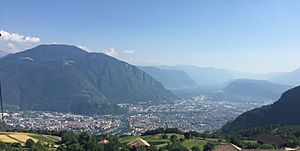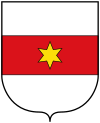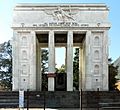Bolzano facts for kids
Quick facts for kids
Bolzano
|
|||
|---|---|---|---|
| Comune di Bolzano Stadt Bozen |
|||

Panorama of Bolzano
|
|||
|
|||
| Country | Italy | ||
| Region | Trentino-Alto Adige/Südtirol | ||
| Province | South Tyrol (BZ) | ||
| Area | |||
| • Total | 52.3 km2 (20.2 sq mi) | ||
| Elevation | 262 m (860 ft) | ||
| Population
(March 2018)
|
|||
| • Total | 107,436 | ||
| • Density | 2,054.2/km2 (5,320/sq mi) | ||
| Demonym(s) | Italian: bolzanini German: Bozner Ladin: bulsanins |
||
| Time zone | UTC+1 (CET) | ||
| • Summer (DST) | UTC+2 (CEST) | ||
| Postal code |
39100
|
||
| Dialing code | 0471 | ||
Bolzano is an important city in northern Italy. It is the main city of the Province of Bolzano-Bozen, which is part of the Trentino-Alto Adige/Südtirol region. You might also hear its German name, Bozen, or its Ladin name, Bulsan.
Bolzano is home to over 107,000 people (as of March 2018). It covers an area of about 52 square kilometers. The city sits at an elevation of 262 meters above sea level.
Contents
A City of Many Languages and Cultures
Bolzano has a fascinating history with different languages. People who spoke Italian have lived here since the Middle Ages. The wider region of Alto Adige/Südtirol mostly speaks German. However, in Bolzano city, Italian speakers are the majority.
In 2001, about 75% of the people in Bolzano spoke Italian. Around 24% spoke German, and a small number spoke Ladin. Ladin is a very old language spoken in some parts of the Alps. Today, about 7% of the people in Bolzano were born in other countries, mostly from Eastern Europe.
A Look Back in Time
For many centuries, the area around Bolzano was influenced by both Italian and German cultures. Originally, people who spoke a language similar to Latin lived here, dating back to the Roman Empire. Over time, especially between the Renaissance and the 1800s, more German-speaking people moved into the area.
After World War I, Italy gained control of this region. The Italian government encouraged many Italian families to move to Bolzano. The city was modernized with new buildings and factories. Because of this, Italian speakers became the majority in Bolzano. In 2011, nearly 77% of the population spoke Italian.
Bolzano Today
Today, Bolzano is a very modern and international city. It has a special university called the Free University of Bolzano. Here, students can study in English, German, and Italian! The city also has the European Academy (EURAC) and a Business Innovation Centre (BIC).
Bolzano has its own international airport, with daily flights to cities like Rome and Munich. There's also a large "Bolzano Fair Area" where many events and exhibitions take place.
One of the most famous places to visit is the Archaeology Museum. It's home to Ötzi the Iceman, a mummy from over 5,000 years ago! You can also explore the old Tyrolean medieval center with its unique covered walkways called "Portici" or "Lauben."
Bolzano is also important for cooperation between regions. It's a center for the "Euregio Tirol-Südtirol/Alto Adige-Trentino." It also works with Innsbruck in Austria as a capital of the "Alps Convention." This group helps protect the Alps and promotes sustainable development.
City Districts and Nearby Towns
Bolzano is divided into five main city districts:
- Centro-Piani-Rencio (German: Zentrum-Bozner Boden-Rentsch)
- Don Bosco
- Europa-Novacella (German: Europa-Neustift)
- Gries-San Quirino (German: Gries-Quirein)
- Oltrisarco-Aslago (German: Oberau-Haslach)
Some towns located very close to Bolzano include Appiano, Cornedo, Laives, Deutschnofen, Renon, Genesio, Terlan, and Vadena.
Other important towns in the wider region are Bressanone, Brunico, and Merano.
Twin Cities
Bolzano has a special friendship with one city:
Images for kids
-
Bolzano and the Alps
-
Statue of Walther von der Vogelweide
See also
 In Spanish: Bolzano para niños
In Spanish: Bolzano para niños






































